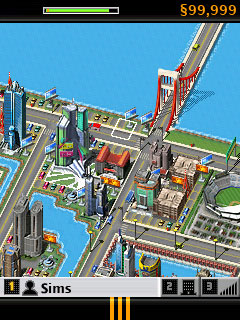
Fitting games of true scale onto mobile is a difficult task. With complex strategy games reduced to a selection of menus thanks to the mobile's limited controls and screen size, the end result is often less than appealing. Massive-game-of-the-moment Spore Origins got around this by including about a fifth of the content of the PC original, but SimCity Metropolis tries its best to recreate as much of the city-building original game as possible.
As such, it's your job to build a city pretty much from scratch. Your city already has roads, so you only have to place the buildings themselves. These are split into three main categories. There are residential buildings to house your residents, industrial buildings for them to work in and amenities to make your city a nicer place to be.
Each building affects several of the stats that your city is judged by. These are things like the happiness of your citizens, the amount of jobs available, whether there's enough power to keep the lights on, and how productive the city is in industry terms. Big grim buildings that supply your population with jobs are likely to cause a dip in happiness while leafy parks will keep them happy and make the place look nice, but won't contribute much more.
You've got a limited space to work with, and you need to balance out the city stats in order to complete each level's objectives. Yes, although you're working towards building one city, the game is still spread out into level-based chunks. In fact, most of the game dynamics are similar to last year's SimCity Societies. In each game segment, you have certain objectives to achieve. You'll need to get your population or one of the city stats up to a certain level, and you're only given a set number of months in which to achieve this. You'll generally have to make a new building or two, unlocked by completing the other objectives.
However, what Metropolis has over its socialist cousin is an excellent execution of the structure that made the original SimCity so compelling. Not only is the game split into levels, but there are also three separate islands that represent the residential, industrial and commercial 'districts' of the city. You'll still get the chance to put down some grim-looking grey slabs in the residential district, just as you'll need to build housing on the industrial island, but each has its own building set and general flavour. The residential zone has a pleasant green tileset, working its way down to a sludgy brown colour in the industrial sector.
As you progress, more of each island is uncovered from the sea, using such charmingly clunky plot devices as earthquakes to justify the change. The islands move from being quite distant to being separated by only a small channel. You don't ever actually get to unite the three districts, but even as just a visual device it keeps you hooked into the development of your city. Plus, the fact that you have to finish a round of levels in each district before returning to the first stops you from getting mired in residential tower blocks or industrial parks.
Peppered throughout each level are encounters with the city's main characters, from the resident superhero SuperSim to the police chief and local crime boss, and these regularly pop up to pose conundrums, some of which have moral implications: will you let aliens abduct buses full of your residents for experimentation? It might sound like a straight 'no,' but those extra-terrestrial types pay well.
Finances are rarely an issue, though, especially towards the end of each level, but these encounters are a welcome break from world-building, especially when the characters themselves are so well drawn. They're consistent throughout the three districts, too, once again pulling them together into a convincing semblance of a city.
The thing that really tricks you into believing in the city SimCity Metropolis offers you, though, is that throughout the whole game what you have made previously remains intact. So, although the city-building is split into levels, it's always clear that you're working on a single over-arching project.
And what a project. The game interface is so brilliantly intuitive that the relatively complicated balancing of the many city stats is perfectly smooth in practice. It relies on icons rather than text, meaning it's all supremely easy on the eyes. Presentation overall is superb, and somehow EA has managed to cram 120 buildings into the game in total.
We haven't had time to count them all, but the numerous buildings introduced at every interval of the game puts a stop to any visual stagnancy. Considering SimCity Metropolis sees you staring at the same isometric cityscape view throughout, this is an impressive feat.
Once you've made your village into the metropolis of the title, a free-play mode is unlocked, allowing you to carry on building without any defined objectives. To an extent, this mode reveals quite how important the tight, objective-based structure is in the game.
After a while you may well find yourself tiring of simply optimising your city, but by then you'll have had enough hours of fun to have lost the right to complain. It's a symptom of the cut-down strategy that's employed here - the relatively uncomplicated relationships between happiness, crime and pollution make the city appear more obviously algorithmic, and hence less organic, than the original game whose blueprint Metropolis uses.
Within the context of the objective-based levels though, the city is always a fun place to hang out.
SimCity Metropolis
